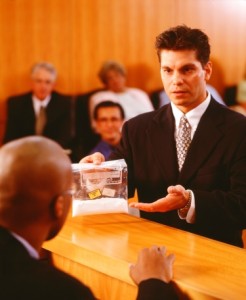 In July, I was selected to serve on a jury for an armed robbery trial at the Oakland County Courthouse. I’d never watched a real trial, only seen clips on CNN from particularly salacious, high-profile cases–Jodi Arias and Casey Anthony most recently. The armed robbery case wasn’t salacious, just kind of strange and full of inconsistencies. But just like on t.v., the stakes in the courtroom were high. And even more compelling were the elements of argument present throughout the trial–the defense and the prosecution battling it out over their claims, the witnesses presenting their versions of the story, which the lawyers shaped into evidence with their lines of questioning and opening and closing statements. Over those two and a half days, argument came to life for me in a way that it never had when I taught academic argument in middle school and college classrooms.
In July, I was selected to serve on a jury for an armed robbery trial at the Oakland County Courthouse. I’d never watched a real trial, only seen clips on CNN from particularly salacious, high-profile cases–Jodi Arias and Casey Anthony most recently. The armed robbery case wasn’t salacious, just kind of strange and full of inconsistencies. But just like on t.v., the stakes in the courtroom were high. And even more compelling were the elements of argument present throughout the trial–the defense and the prosecution battling it out over their claims, the witnesses presenting their versions of the story, which the lawyers shaped into evidence with their lines of questioning and opening and closing statements. Over those two and a half days, argument came to life for me in a way that it never had when I taught academic argument in middle school and college classrooms.
When the trial was over, I considered ways to simulate legal argument to help students understand the elements we want them to use in their analytical writing. Simulation provides the best in experiential learning; it’s an active, engaging teaching strategy that allows for both student content application and discovery. Using a trial-based simulation involving the elements of argument could help concepts stick and be a great interdisciplinary activity for ELA and social studies classrooms.
Jury Selection – Bias
I’ve always found bias in texts to be a difficult and complex concept to teach. The jury selection process, which took as long as the trial, proved to be a true illustration of bias. During a process called voir dire, the prosecution and defense attorneys questioned jurors to unearth their potential biases about the case. We were asked about our employment, family, and lifestyle. The answers were fascinating and sometimes awkward. What seemed most important though were questions about any experiences or connections to law enforcement and experience as a victim or perpetrator of a crime.
The prosecutor released the college kid with a mohawk; questioning revealed the guy had an anti-authority attitude, which his hair had told me the moment he walked into the courtroom. The numerous potential jurors who’d been victims of armed robbery (or had friends or loved ones who had been) were released by the defense attorney. A former parole officer was also let go by the defense. Another key element of bias the lawyers tried to determine was whether we would assume innocence until proof of guilt. A young mother of three freely admitted that she could not, stating that we were clearly “here for a reason.” The defense attorney released her immediately.
Lesson Idea: Provide your students with a courtroom scenario related to the theme or topic they’re currently studying. Assign students to the role of potential juror, defense team, or prosecution team. Have students simulate the voir dire process, with the lawyers deciding which jurors remain on or leave the jury. Following the selection of twelve jurors, have the class reflect on the bias evident in particular jurors and the nature of the questions the lawyers asked to expose that bias. Finally, have students consider the kinds of questions they can ask of texts to determine bias.
Opening Statements – Claims & Persuasion
 The trial began with opening statements–the lawyers submitting claims of guilt and innocence to us with an overview of the evidence, angled differently by the prosecution and the defense. Our attention was grabbed; we were enticed first by one side, then the other. It felt a lot like the opening paragraphs of a good essay.
The trial began with opening statements–the lawyers submitting claims of guilt and innocence to us with an overview of the evidence, angled differently by the prosecution and the defense. Our attention was grabbed; we were enticed first by one side, then the other. It felt a lot like the opening paragraphs of a good essay.
Throughout the trial, I was struck by how the personalities of both the lawyers and the witnesses influenced my willingness to believe claims and evidence. I felt one lawyer was sharper than the other. And the prosecutor cast himself as understanding and unintimidating, which seemed somewhat false. Many of the witnesses seemed shady or to have poor memories. None of these impressions were based on pure fact, and so, the element of persuasion came swiftly into my jury experience.
Lesson Idea: To practice crafting complex claims and evidence, provide students with a controversial scenario at school or in their community that they’re all familiar with. Assign small groups to either the pro or con side of the issue. Ask them to craft “opening statements” that make a claim and lay out the evidence, angled to persuade a given audience. Ask them to consider how they would change their opening statement for a different audience. To practice public speaking skills, have students deliver their statements to the class or video tape themselves delivering their “opening statements.”
Witness Testimony – Data vs. Evidence
 A few cops testified, then a friend of the supposed victim, and then the victim himself. No one had the same story. Few elements of the witnesses’ narratives even overlapped–there was a knife involved, and it was a bitter cold day. That was it. But the prosecutor and the defense attorneys’ lines of questioning were both artful — they constructed arguments with their questions.
A few cops testified, then a friend of the supposed victim, and then the victim himself. No one had the same story. Few elements of the witnesses’ narratives even overlapped–there was a knife involved, and it was a bitter cold day. That was it. But the prosecutor and the defense attorneys’ lines of questioning were both artful — they constructed arguments with their questions.
We had been instructed by the judge to listen only to the witnesses’ answers, not the lawyers’ questions. The lawyers wanted our understanding of the answers to be biased by the questions that elicited them. So we had to treat testimony as data. It only became evidence once each of us passed judgment on the credibility of the testimony and how it compared to the other data we had collected during testimony.
Lesson Idea: When students research, they collect data. Just like a jury, they must decide how credible sources are and compare all the data collected to determine inconsistencies and facts. This process allows them to then select the evidence with which they will craft an argument. To simulate the process of how data becomes evidence, provide students with the story of a crime. (A common argument exercise like Slip or Trip is one example.) Assign students to play the roles of key characters in the story, as well as police officers or detectives. Have the rest of the class cross examine the characters, then have a full class discussion about the credibility of each witness and their testimony. Who seemed credible? How come? Have the class make a determination of guilt or innocence based on their decisions about the data they received during testimony.
Deliberation – Arguing with Other Jurors
Being in the jury room became an exercise in argument as well. Two of the twelve jurors felt the defendant was guilty and asked the rest of us to explain our reasonable doubts–to make our case. Some people were general: “It just doesn’t add up.” Others were more specific: “A thief who doesn’t run or makes threats when the victim calls 911 might not be a thief.” I pointed out that the supposed victim started laughing at one point in the 911 recording, so he couldn’t have felt too traumatized. Could we say for sure that a crime had occurred? These specifics were what made the difference in our argument and turned the two “guilty” jurors to “not guilty.” They weren’t 100% convinced of the defendant’s innocence, but they didn’t have to be. They now shared our reasonable doubts. We gave our verdict and were released from our civic duty.
Testing Theories & Relevance
My jury experience reinforced how important it is for students to practice argument by experimenting with different theories through talk before they write. The discussion I had with my fellow jurors during deliberation was all about testing our theories with the evidence we had been supplied. And together we came to a decision that would significantly affect one man’s life, which made the importance of being able to understand and craft an argument take on a whole new kind of importance.
Resources
If you’re interested in trying out a court-based simulation to teach argument in your classroom, consider using some of the resources below.
United States Federal Courts website – activities concerning impartiality, collegiality, and civil discourse
Mini Simulation of a Supreme Court Oral Argument
iCivics website
- Argument Wars: students argue real Supreme Court cases
- James Bond in a Honda: a trial simulation lesson
- We the Jury: students decide a case based on evidence presented
Michigan Supreme Court Learning Center – Teen Court Simulation
 Delia DeCourcy joined Oakland Schools in 2013 after a stint as an independent education consultant in North Carolina where her focus was on ed tech integration and literacy instruction. During that time, she was also a lead writer for the Common Core-aligned ELA writing units. Prior to that, she was a writing instructor at the University of Michigan where she taught first-year, new media, and creative writing and was awarded the Moscow Prize for Excellence in Teaching Composition. In her role as secondary literacy consultant, Delia brings all her writing, curriculum design, administration, and teaching skills to bear, supporting districts in their implementation of the Common Core via onsite workshops and consultations, as well as workshops at Oakland Schools. She is currently spearheading the development of literacy-focused online professional learning modules as well as the building of a virtual portal where Michigan educators can learn and collaborate.
Delia DeCourcy joined Oakland Schools in 2013 after a stint as an independent education consultant in North Carolina where her focus was on ed tech integration and literacy instruction. During that time, she was also a lead writer for the Common Core-aligned ELA writing units. Prior to that, she was a writing instructor at the University of Michigan where she taught first-year, new media, and creative writing and was awarded the Moscow Prize for Excellence in Teaching Composition. In her role as secondary literacy consultant, Delia brings all her writing, curriculum design, administration, and teaching skills to bear, supporting districts in their implementation of the Common Core via onsite workshops and consultations, as well as workshops at Oakland Schools. She is currently spearheading the development of literacy-focused online professional learning modules as well as the building of a virtual portal where Michigan educators can learn and collaborate.
